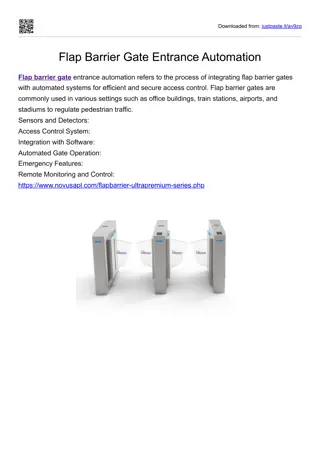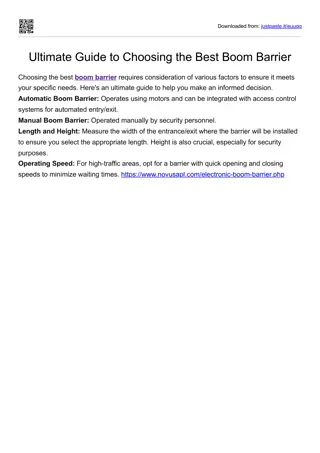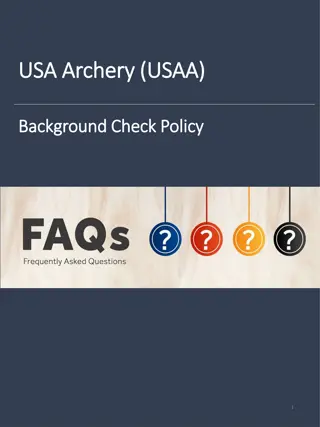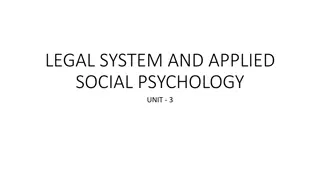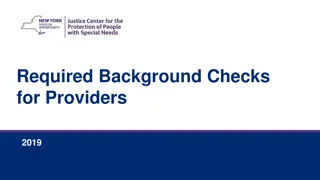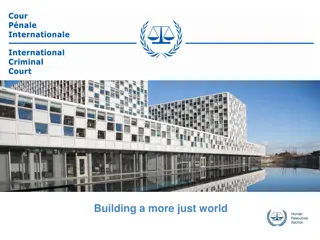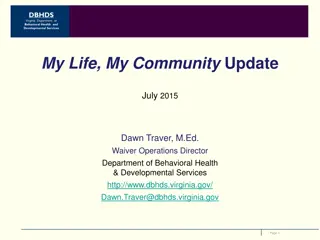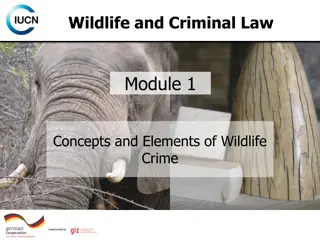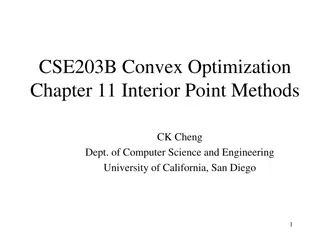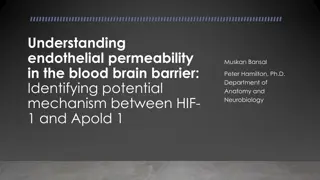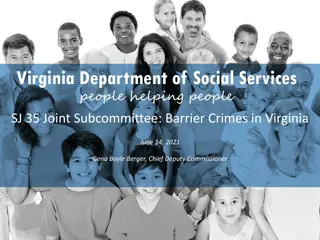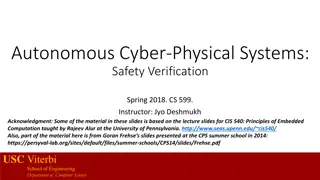Study on Barrier Crimes and Criminal History Checks for DBHDS Facilities
This study discusses barrier crimes for DBHDS facilities, licensed providers, and CSBs, emphasizing the impact of drug-related crimes and misdemeanors on employment eligibility. It addresses time limits following convictions, exceptions, waivers, and appeals processes. Demographic data related to barrier crimes is highlighted without specific capture. Policy decisions regarding the disqualification of individuals from certain roles are also outlined.
Download Presentation

Please find below an Image/Link to download the presentation.
The content on the website is provided AS IS for your information and personal use only. It may not be sold, licensed, or shared on other websites without obtaining consent from the author.If you encounter any issues during the download, it is possible that the publisher has removed the file from their server.
You are allowed to download the files provided on this website for personal or commercial use, subject to the condition that they are used lawfully. All files are the property of their respective owners.
The content on the website is provided AS IS for your information and personal use only. It may not be sold, licensed, or shared on other websites without obtaining consent from the author.
E N D
Presentation Transcript
Barrier Crimes for DBHDS Facilities, Licensed Providers, and CSBs Joint Subcommittee to Study Barrier Crimes and Criminal History Records Checks June 14, 2021 Stacy Pendleton Chief Human Resources Officer, DBHDS Virginia Department of Behavioral Health & Developmental Services
What should and should not be a barrier crime? This is a policy decision for the Commission to decide. Drug-related crimes and misdemeanors are two areas that significantly impact a large number of applicants. Many of these applicants have lived experience, or first-hand experience with mental health or substance use challenges, which can be an invaluable in the provision of services and essential to the growth of peer services. The Code of Virginia cites 176 barrier crimes that disqualify an individual from employment in licensed adult and child behavioral health and developmental services program. Many of these crimes we have never seen on a background check. DBHDS does not have any federal barrier crime code/regulation to follow.
Time limits following convictions Currently in the Code, both 5 years and 10 years are used as time limits in certain instances. Felony-Possession of controlled substances ( 18.2-250): if 5 years have passed from the date of conviction to the application date for employment or discharge date of probation, the individual may be eligible. Misdemeanor Assault and Battery or Misdemeanor Assault and Battery of a Family Member ( 18.2-57.1 and 18.2-57.2): Licensed providers can hire an individual if they were convicted if 10 years has passed from the application date for employment. However, there only can be one conviction.
Exceptions, waiver, or appeals process DBHDS currently has a screening process for 26 crimes that are related to substance use or mental health. This could be expanded on as an appeal process. Screening is at the discretion of the employer and applies only if the individual has met specific code requirements including: o It has been 5 or more years since the conviction o Charges must be related to substance abuse or mental illness o Completion of all prison or jail terms o Shall not be under probation or parole supervision o No pending charges in any locality o Shall have paid all fines, restitution, and court costs for any prior convictions, and shall have been free of parole or probation for at least five years for all convictions Screening is permissive only. Some employers do not consider screening for applicants. Screening is conducted by a licensed behavioral health provider. The assessment is to determine if the offense was substantially related to an individual s mental health or substance use disorder and if the individual is likely to reoffend. The employer receives the result of the screening and then can decide if they wish to move forward with the employment offer.
Demographic data 2021 as of 2/28/21 25 4 4 17 2018 2019 2020 TOTAL Barrier Crimes DBHDS does not capture demographic data related to barrier crimes. However, we can report on which crimes have the largest number of non-eligible individuals. Assault & Battery (misdemeanor) Robbery (felony) Distribution of Controlled Substance (felony) Possession w/intent to distribute (felony) Assault & Battery of Family Member (misdemeanor) Drugs Possession Schedule I or II (Conviction less than 5 years) (felony) Burglary - B/E w/intent to commit felony (felony) Possession of Burglarious Tools (felony) Drugs Possession Schedule I or II (Less than 5 years from probation discharge) (felony) Felonius Assault (felony) Unlawful Malicious Wounding (felony) Assault Police Officer or Firefighter (felony) Distribution to accommodate another (felony) 102 27 26 25 200 36 48 27 177 34 42 31 504 101 120 100 22 32 43 7 104 16 20 27 5 68 The vast majority of assault and battery and assault and batter of a family member charges are over 10 years old, but the individual holds more than one conviction, making them ineligible. 9 29 15 4 57 7 4 2 0 13 4 0 0 1 5 4 4 4 3 1 2 4 1 4 0 7 2 0 0 0 0 9 6 15 6
Recidivism rates DBHDS does not have data on recidivism rates of barrier crimes. Data from the Bureau of Justice Statistics indicates that recidivism rates decline by year after arrest. 43.9% of released prisoners are re-arrested in in the first year following the initial rest, whereas only 1% are re-arrested in the 9th year after initial arrest
Other state approaches to barrier crimes State approaches to eligibility for employment in sensitive positions vary widely. Illinois, for example, lists barrier crimes in its statute, but allows for waiver or reconsideration of any crime. Some states, such as Nevada and Alaska, list barrier crimes tiered by length of disqualification. Some crimes result in permanent eligibility. Others may result in eligibility for a period between 3 and 10 years. Florida lists barrier crimes by professional licensure.
Tiered levels of barrier crimes Approaches to tiers of barrier crimes could look at categories such as misdemeanors vs. felonies or drug-related crimes vs. other crimes. Different time limits for varying categories of crimes could be implemented. Additionally, time limits could be shorter for individuals who are free of probation and parole. Another approach is requiring an appeals process for felony convictions but implementing time limits for misdemeanors.
Virginia Code sections that relate to the DBHDS barrier crimes ( 37.2-314, 408.1, 416 & 506) As a condition of employment, the Department facilities shall require background checks for any applicant who: i. accepts a position of employment at a state facility and was not employed by that state facility prior to July 1, 1996 ii. accepts a position with the Department that receives, monitors, or disburses funds of the Commonwealth and was not employed by the Department prior to July 1, 1996. Every DBHDS Licensed Provider, including CSBs, shall require background checks for: any individual who accepts employment in any direct care position or supervising any direct care position any applicant for approval as a sponsored residential service provider any adult living in the home of an applicant for approval as a sponsored residential service provider any person employed by a sponsored residential service provider to provide services in the home
How the Barrier Crime Law Effects the BH Workforce One of the many challenges in the public safety net is the recruitment of qualified applicants to help meet the growing behavioral health/developmental services workforce needs. For many individuals seeking employment, convictions resulting in employment barriers are decades old. Many are qualified applicants who can provide valuable services. Additionally, many have lived experience, or first-hand experience with mental health or substance use challenges, which can be an invaluable in the provision of services and essential to the growth of peer services.
Differences between licensed providers and DBHDS facilities If an individual is seeking employment in a licensed adult mental health or substance abuse treatment program or DBHDS facility and has any of the screenable barrier crimes found in both 37.2 314 (C), 416 (C) and 506 (C), they may be eligible for a screening and be able to work. Screening does not apply to children s residential or the following DBHDS facilities: CCCA, VCBR, and SEVTC. In addition, there is another screenable barrier crime found in 37.2 416 (D) and 506 (D), which is 18.2-57 (C) Felony Assault and Battery of a Law-Enforcement Officer . If the individual meets the stipulations outlined in this section, they may be eligible for a screening and be able to work. Only applies to licensed providers and CSBs.
Chapter 4 Crimes Against the Person ( 18.2-30 through 18.2-76.2) Misdemeanor Assault and Battery Individuals that have been convicted of more than 1 conviction over 10 years There were a total of 450 individuals Range of years of convictions were from 1980 to 2011 Individuals that have been convicted of more than 1 conviction less than 10 years There were a total of 105 individuals Range of years of convictions were from 1975 to 2010 Misdemeanor Assault and Battery of Family Member Individuals that have been convicted of more than 1 conviction over 10 years There were a total of 114 individuals Range of years of convictions were from 1992 to 2016 Individuals that have been convicted of more than 1 conviction less than 10 years There were a total of 65 individuals Range of years of convictions were from 1987 to 2015
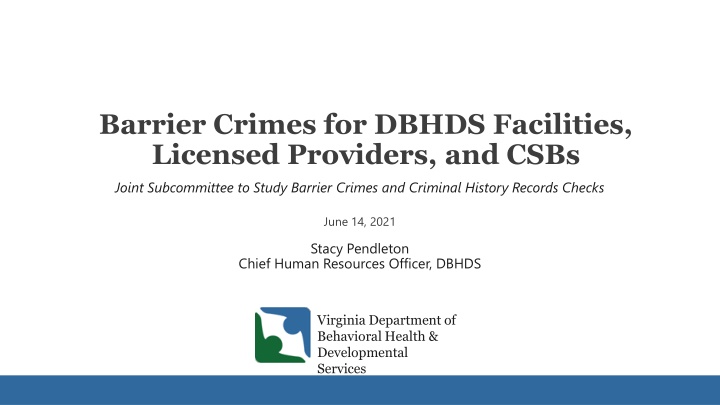

![Prevention and Combating of Hate Crimes and Hate Speech Bill [B.9B.2018]](/thumb/60513/prevention-and-combating-of-hate-crimes-and-hate-speech-bill-b-9b-2018.jpg)

